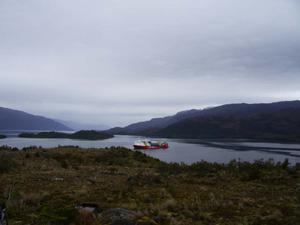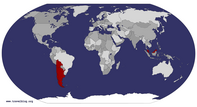Advertisement
Published: January 22nd 2007

 Navimag Ferry
Navimag Ferry
Marooned Navimag FerryWEEK 5 MAROONED AT SEA!
I was only in transit through Punta Arenas but I have the impression of brightly coloured houses - painted corrugated iron roofs and wooden walls shining in the sunshine.
The bus ride from Punta Arenas to Puerto Natales was mainly though pampas with the high Andes on the horizon to the west. There were numerous estancias rearing cattle and sheep and local residents hopping on and off the bus at places seemingly in the middle of nowhere. I sat next to a Japanese lady who was an interpreter speaking Italian, French and English. She was in Chile to brush up her Spanish so that she could interpret commentaries for international football matches. As Italy was recently eliminated at an early stage in a rent competition she found herself with a few weeks to spare so she was visiting Chile.
My hostel in Puerto Natales was Ok. Omar and his black labrador, Aya, were very welcoming and helpful. After all the enormous meals on the cruise I enjoyed my staple diet of tuna and sardines in olive oil, tomatoes, avocado and fruit. Fortunately I can still fit into my only pair of size 10

 Navimag Ferry
Navimag Ferry
A trip to Port Edentrousers. I shared a dorm with 2 Americans and rose early next morning to catch a tour to Parque Nacional Torres del Paine. - reputedly one of the finest parks in South America.
We visited Milodon cave, a vast cave 200m deep, 30m high and 80 m wide, capped with a resistant conglomerate rock - the softer sandstones beneath being eroded by waves of a former lake. Archaelogical evidence suggests that it was inhabited by Patagonian primitive man 12000 years BP who was a hunter. Bone and fur from a previously unknown animal were also discovered and believed to be the remains of the milodon a large herbivorous ground sloth which became extinct in the late Pleistocene 8-10000BP. We had numerous photo stops for guanacos (llamas), nandus, ostrich like birds and flamingos. A brave silver fox sat at the edge of the car park hopeful of a tasty treat. Most photographed were the amazing snow capped granite peaks or tors rising to 2800 m set beyond brilliant turquoise lakes fed by glacial melt water. The view from the road merely gives an impression of the beauty of the peaks. The fit and enthusiastic take a 5 or 7 day
treck to really appreciate the enormity and vastness of the park. In the late afternoon we walked through mature lenga forest with the tallest trees I have seen so far. The path led to a viewing point for the Grey glacier. Scrambling over the terminal moraine it was possible to see huge ice bergs glistening in irradescent shades of blue. We were so late back that it was a rush to catch the Navimag ferry. Having checked in the clerk kindly let me delay embarking until 10 pm in order to have a meal. The portion of steak served in the restaurant was so large that I am beginning to crave vege food!
“Magellenes” the large sea going ferry links the remote southern settlements of Chile, including Puerto Natales to Puerto Montt. It is 123 m long and 31 m wide. It carries 150 passengers, containers, trucks, cattle and sheep. The journey takes 4 days and the route of 1500K follows the coast of Chile where the Andes sweep to the sea and where there is no road. The route passes through beautiful fiords and channels and for a large part it is sheltered by islands from the stormy
blast of the Pacific Ocean.
I found myself sharing a cabin 4 berth cabin with a Chilean family. Hector, Nadia and Paloma their 15 month old daughter were delightful. With poco espaniol and poco ingles - we had many amusing attempts to communicate. I was soon drinking ‘pisco sour’, the national Chilean drink of brandy and lemon, and sharing the vino tinto and the ron (rum) and coke which I had brought for the new year celebrations. Little Paloma was a good baby and laughed all the time - and she slept all night which was amazing!
The crew provided an educational programme with talks on local geography, glaciation, indigenous peoples, local fauna and flora and there were films, videos and documentaries. We diverted to see the impressive Amalia glacier from the ferry. The brilliant sunshine illuminated a rather majestic cruise ship which gave scale to the snout and extent of the crevassed glacier. Later we disembarked at Port Eden , the first sign of habitation, and one of the few settlements along the route. The local fishermen ferried us across to the shore in boats which looked rather old and dilapidated. Port Eden, with a population of
200 is located on a promontory extending into the Pasa de Indio channel. The brightly painted houses of wood and colourful boats reminded me of the Lofoten islands off the north west coast of Norway. The surrounding landscape, the hills and the islands could have been the west coast of Scotland. The community thrives through fishing and handicrafts sold to passenger of passing ferries and cruise liners.
Here live the 15 remaining Kaweskar indigenous people, who formerly lived in these wild and remote fiords. They lived along the shoreline in houses on stilts covered in sea lion fur. The men chipped out 8 meter long, 1.2m deep canoes from the northofagus correi evergreen tree. The ladies swam naked in the sea diving for fish and huge mussels while the men steered the boats through the rapid currents. Children lit and tended fires in the canoes for warmth, cooking and opening the mussel shells. (The lighting of fires everywhere by the indigenous populations led to the name Tierra del Fuego. It is not a land of volcanoes as I had always imagined!)
Once on shore we followed a boardwalk above the marshy ground which acted as a pathway giving access for residents. No cars or bicycles here. A further boardwalk gave access to a viewpoint on the hill from which we could see wonderful views of the channel and our over sized ferry offshore.
A fascinating walk. Many rather dilapidated houses constructed of wood and corrugated iron and supported on stilts at the front to accommodate the steep slopes. Over head a web of electricity and telephone wires and TV aerials. No mobile signal here! I am fascinated by back yards and gardens and I enjoyed peering over fences. Piles of mussel shells, fishing nets and lobster pots, rusting 40-gallon oil drums. Washing drying under cover as it nearly always rains here. Plastic water tanks giving a head of water for domestic use. Hens with chick scratched in the undergrowth . On each door step sheltering under a canopy were dogs and cats who scurried out to greet me. Very occasional gardens on small deltas growing potatoes, cabbage and rhubarb and hedged with raspberry canes and blackcurrant bushes. Along the shore line with no beach were rotting jetties and old boats.
All was going fine - and then a mandatory summons to assemble in the dining room.. A rather flustered old style captain with smart white shirt, tie and trousers -followed by a rather serious look naval crew appeared. The captain spoke for several minutes in severe tones which was translated equally severely. We learned that an engine was broken and that we would have to wait for 3 days for another ship to rescue us - the 4 day journey will take over a week. So here we are - in a calm channel surrounded by spectacular landscapes marooned on a metallic island! (I am very grateful-it could be the open sea!) For me there is no problem. A quick ferry ride to use the phone in Port Eden and a call to Betty my kind neighbour in Perth, who agreed to email Carole and let her know that I will be at least 5 days late catching her up somewhere in mid west Argentina. My regret is that I will miss her birthday! For me it is bliss to be stranded and to be completely relaxed. No tickets to buy, buses to catch, meals to think about or somewhere to sleep! For other passengers who have pre-booked accommodation and flights tension is running high as Navimag will not commit to arrival times of the rescue boat or compensation.
My sadness is for the cattle below constrained within a double decker cattle float with standing room only. Initially they were without food and water - but now grass is being cut on shore and bagged in, the cattle are being washed and water is being provided.
For the second time I was marooned for New Year. Two years ago I celebrated new year in Kenya in the Masai Mara game reserve in the dark and the rain without lights, food or blankets, in a big Bedford safari truck which had skidded into a ditch and was well and truly stuck. Outside the hyenas howled and the wind was so strong that it was hard to hold down the awnings. Navimag, however, came up trumps in providing free wine and nibbles and a party and new year 2007 was successfully celebrated!
And now another day in our floating hotel surrounded by ever changing landscapes. The occasional sunshine highlighting snow capped peaks, high mountains, rolling hills and tree covered islands or dark clouds and rain reducing them to mere silhouettes in the mist. We still don’t know when the rescue ferry will arrive!
Advertisement
Tot: 0.073s; Tpl: 0.02s; cc: 7; qc: 45; dbt: 0.042s; 1; m:domysql w:travelblog (10.17.0.13); sld: 1;
; mem: 1.1mb









